Detailed Business Plan Report for ALS Arabia Biyaq LLC
VerifiedAdded on 2020/07/23
|27
|9024
|65
Report
AI Summary
This business plan outlines the strategic direction of ALS Arabia Biyaq LLC, a joint venture between ALS Arabia and Biyaq Laboratories LLC, for the next five years. It details the company's objectives, which include establishing laboratory facilities, defining marketing and sales strategies, and increasing market share in Oman. The plan covers the business model, including investment, operation, and expansion actions, all aligned with the company's vision, mission, and values, emphasizing operational excellence, quality of service, people empowerment, and HSE performance. It includes market intelligence, SWOT analysis, competitor analysis, and advantages of ALS Arabia Biyaq, as well as business and marketing strategies, strategy execution, and a financial plan. The plan aims to become the leading laboratory provider in Oman's oil and gas, environmental, food, and minerals industries, with a targeted ROS of 40% by 2022. The report provides a comprehensive overview of the company's structure, previous sales performance, and future forecasts, along with recommendations for success.
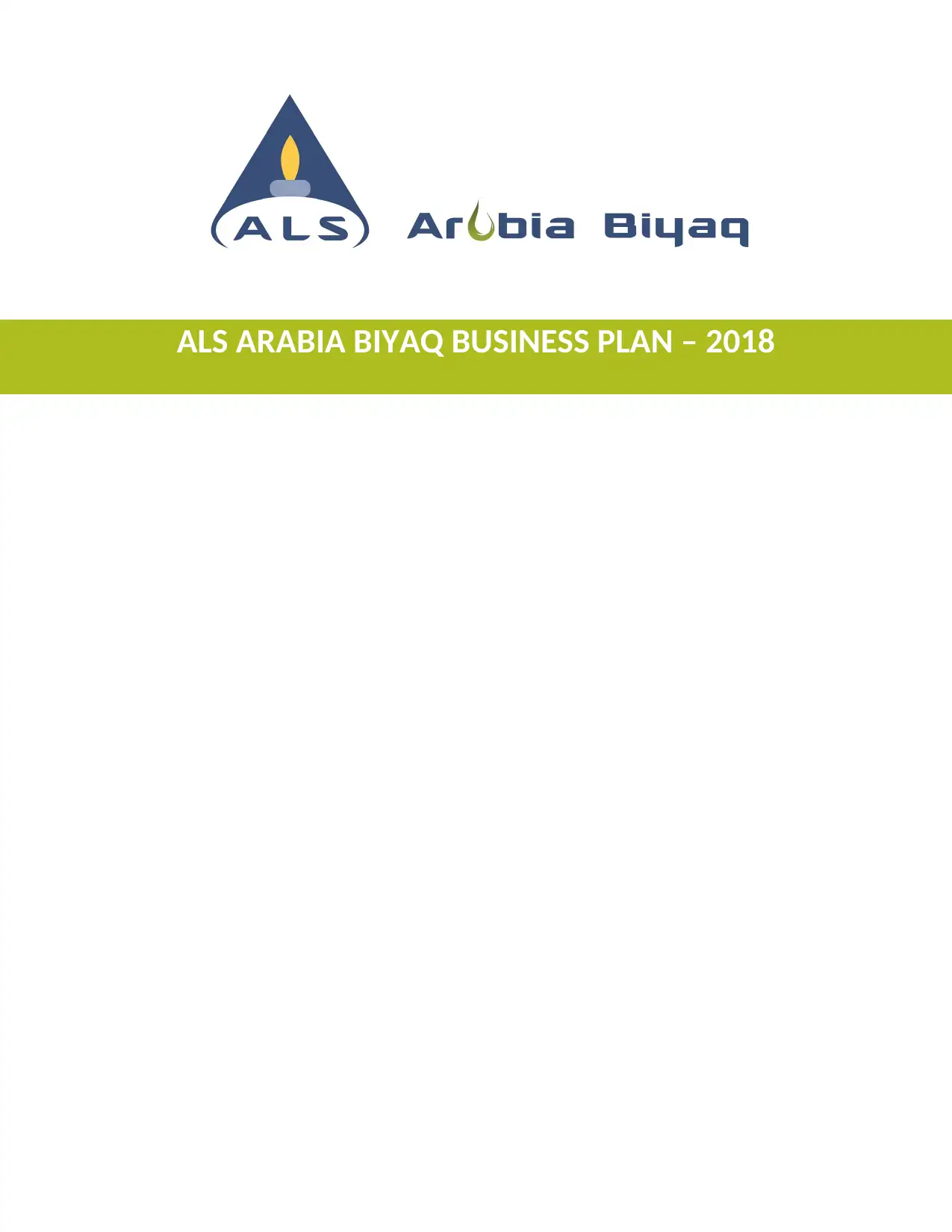
ALS ARABIA BIYAQ BUSINESS PLAN – 2018
Paraphrase This Document
Need a fresh take? Get an instant paraphrase of this document with our AI Paraphraser

2 | P a g e
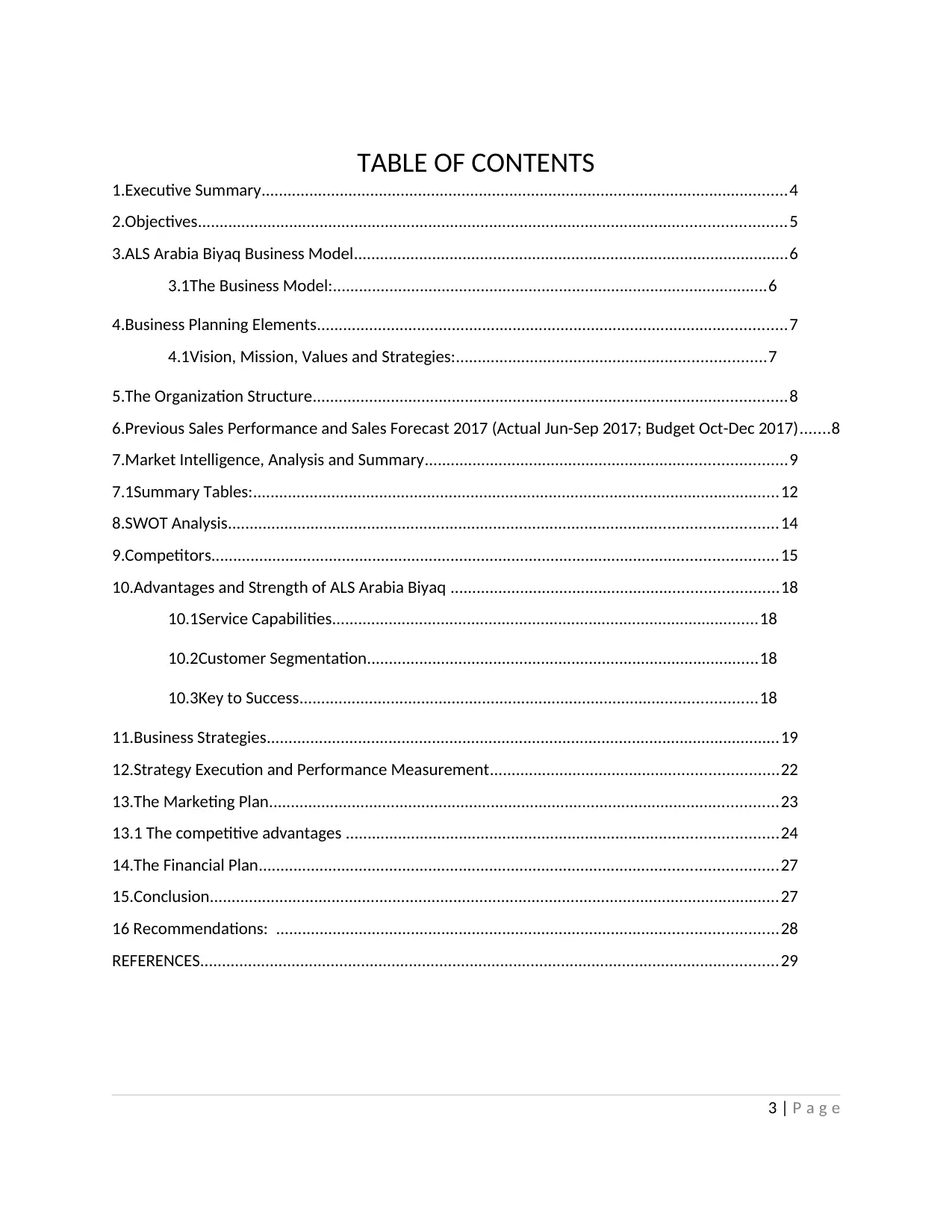
TABLE OF CONTENTS
1.Executive Summary.........................................................................................................................4
2.Objectives.......................................................................................................................................5
3.ALS Arabia Biyaq Business Model....................................................................................................6
3.1The Business Model:....................................................................................................6
4.Business Planning Elements............................................................................................................7
4.1Vision, Mission, Values and Strategies:.......................................................................7
5.The Organization Structure.............................................................................................................8
6.Previous Sales Performance and Sales Forecast 2017 (Actual Jun-Sep 2017; Budget Oct-Dec 2017).......8
7.Market Intelligence, Analysis and Summary...................................................................................9
7.1Summary Tables:.........................................................................................................................12
8.SWOT Analysis..............................................................................................................................14
9.Competitors..................................................................................................................................15
10.Advantages and Strength of ALS Arabia Biyaq ...........................................................................18
10.1Service Capabilities..................................................................................................18
10.2Customer Segmentation..........................................................................................18
10.3Key to Success.........................................................................................................18
11.Business Strategies......................................................................................................................19
12.Strategy Execution and Performance Measurement..................................................................22
13.The Marketing Plan.....................................................................................................................23
13.1 The competitive advantages ...................................................................................................24
14.The Financial Plan.......................................................................................................................27
15.Conclusion...................................................................................................................................27
16 Recommendations: ...................................................................................................................28
REFERENCES.....................................................................................................................................29
3 | P a g e
1.Executive Summary.........................................................................................................................4
2.Objectives.......................................................................................................................................5
3.ALS Arabia Biyaq Business Model....................................................................................................6
3.1The Business Model:....................................................................................................6
4.Business Planning Elements............................................................................................................7
4.1Vision, Mission, Values and Strategies:.......................................................................7
5.The Organization Structure.............................................................................................................8
6.Previous Sales Performance and Sales Forecast 2017 (Actual Jun-Sep 2017; Budget Oct-Dec 2017).......8
7.Market Intelligence, Analysis and Summary...................................................................................9
7.1Summary Tables:.........................................................................................................................12
8.SWOT Analysis..............................................................................................................................14
9.Competitors..................................................................................................................................15
10.Advantages and Strength of ALS Arabia Biyaq ...........................................................................18
10.1Service Capabilities..................................................................................................18
10.2Customer Segmentation..........................................................................................18
10.3Key to Success.........................................................................................................18
11.Business Strategies......................................................................................................................19
12.Strategy Execution and Performance Measurement..................................................................22
13.The Marketing Plan.....................................................................................................................23
13.1 The competitive advantages ...................................................................................................24
14.The Financial Plan.......................................................................................................................27
15.Conclusion...................................................................................................................................27
16 Recommendations: ...................................................................................................................28
REFERENCES.....................................................................................................................................29
3 | P a g e
⊘ This is a preview!⊘
Do you want full access?
Subscribe today to unlock all pages.

Trusted by 1+ million students worldwide
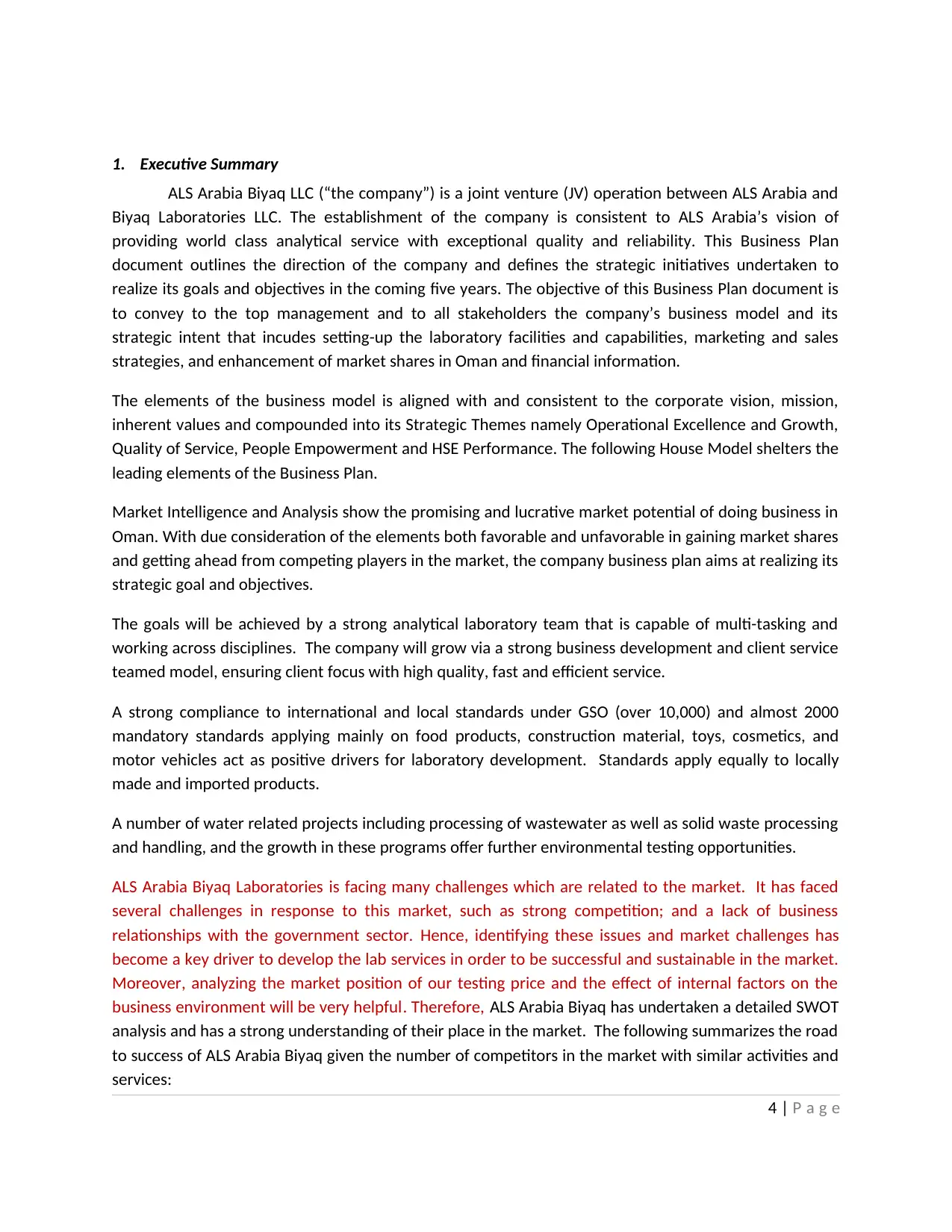
1. Executive Summary
ALS Arabia Biyaq LLC (“the company”) is a joint venture (JV) operation between ALS Arabia and
Biyaq Laboratories LLC. The establishment of the company is consistent to ALS Arabia’s vision of
providing world class analytical service with exceptional quality and reliability. This Business Plan
document outlines the direction of the company and defines the strategic initiatives undertaken to
realize its goals and objectives in the coming five years. The objective of this Business Plan document is
to convey to the top management and to all stakeholders the company’s business model and its
strategic intent that incudes setting-up the laboratory facilities and capabilities, marketing and sales
strategies, and enhancement of market shares in Oman and financial information.
The elements of the business model is aligned with and consistent to the corporate vision, mission,
inherent values and compounded into its Strategic Themes namely Operational Excellence and Growth,
Quality of Service, People Empowerment and HSE Performance. The following House Model shelters the
leading elements of the Business Plan.
Market Intelligence and Analysis show the promising and lucrative market potential of doing business in
Oman. With due consideration of the elements both favorable and unfavorable in gaining market shares
and getting ahead from competing players in the market, the company business plan aims at realizing its
strategic goal and objectives.
The goals will be achieved by a strong analytical laboratory team that is capable of multi-tasking and
working across disciplines. The company will grow via a strong business development and client service
teamed model, ensuring client focus with high quality, fast and efficient service.
A strong compliance to international and local standards under GSO (over 10,000) and almost 2000
mandatory standards applying mainly on food products, construction material, toys, cosmetics, and
motor vehicles act as positive drivers for laboratory development. Standards apply equally to locally
made and imported products.
A number of water related projects including processing of wastewater as well as solid waste processing
and handling, and the growth in these programs offer further environmental testing opportunities.
ALS Arabia Biyaq Laboratories is facing many challenges which are related to the market. It has faced
several challenges in response to this market, such as strong competition; and a lack of business
relationships with the government sector. Hence, identifying these issues and market challenges has
become a key driver to develop the lab services in order to be successful and sustainable in the market.
Moreover, analyzing the market position of our testing price and the effect of internal factors on the
business environment will be very helpful. Therefore, ALS Arabia Biyaq has undertaken a detailed SWOT
analysis and has a strong understanding of their place in the market. The following summarizes the road
to success of ALS Arabia Biyaq given the number of competitors in the market with similar activities and
services:
4 | P a g e
ALS Arabia Biyaq LLC (“the company”) is a joint venture (JV) operation between ALS Arabia and
Biyaq Laboratories LLC. The establishment of the company is consistent to ALS Arabia’s vision of
providing world class analytical service with exceptional quality and reliability. This Business Plan
document outlines the direction of the company and defines the strategic initiatives undertaken to
realize its goals and objectives in the coming five years. The objective of this Business Plan document is
to convey to the top management and to all stakeholders the company’s business model and its
strategic intent that incudes setting-up the laboratory facilities and capabilities, marketing and sales
strategies, and enhancement of market shares in Oman and financial information.
The elements of the business model is aligned with and consistent to the corporate vision, mission,
inherent values and compounded into its Strategic Themes namely Operational Excellence and Growth,
Quality of Service, People Empowerment and HSE Performance. The following House Model shelters the
leading elements of the Business Plan.
Market Intelligence and Analysis show the promising and lucrative market potential of doing business in
Oman. With due consideration of the elements both favorable and unfavorable in gaining market shares
and getting ahead from competing players in the market, the company business plan aims at realizing its
strategic goal and objectives.
The goals will be achieved by a strong analytical laboratory team that is capable of multi-tasking and
working across disciplines. The company will grow via a strong business development and client service
teamed model, ensuring client focus with high quality, fast and efficient service.
A strong compliance to international and local standards under GSO (over 10,000) and almost 2000
mandatory standards applying mainly on food products, construction material, toys, cosmetics, and
motor vehicles act as positive drivers for laboratory development. Standards apply equally to locally
made and imported products.
A number of water related projects including processing of wastewater as well as solid waste processing
and handling, and the growth in these programs offer further environmental testing opportunities.
ALS Arabia Biyaq Laboratories is facing many challenges which are related to the market. It has faced
several challenges in response to this market, such as strong competition; and a lack of business
relationships with the government sector. Hence, identifying these issues and market challenges has
become a key driver to develop the lab services in order to be successful and sustainable in the market.
Moreover, analyzing the market position of our testing price and the effect of internal factors on the
business environment will be very helpful. Therefore, ALS Arabia Biyaq has undertaken a detailed SWOT
analysis and has a strong understanding of their place in the market. The following summarizes the road
to success of ALS Arabia Biyaq given the number of competitors in the market with similar activities and
services:
4 | P a g e
Paraphrase This Document
Need a fresh take? Get an instant paraphrase of this document with our AI Paraphraser
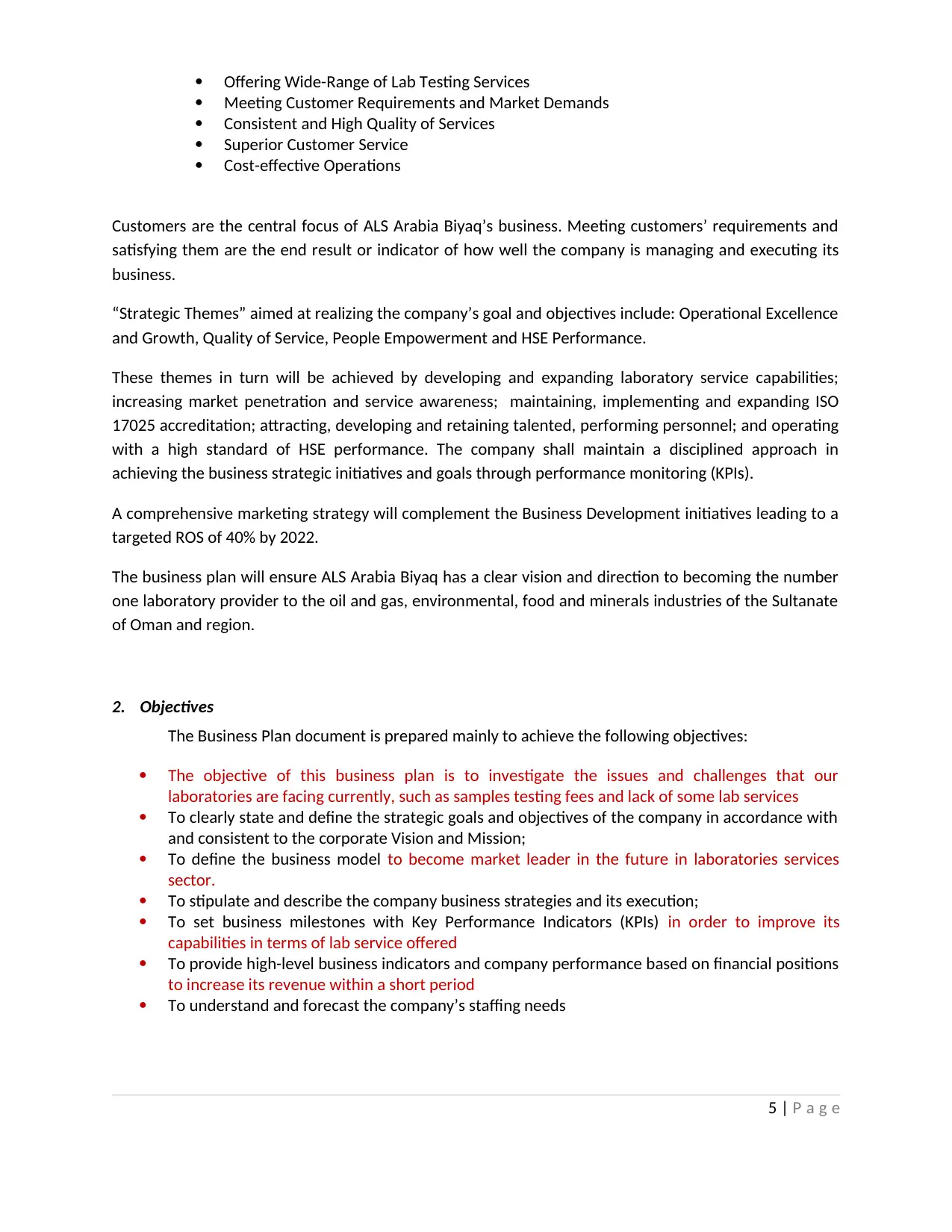
Offering Wide-Range of Lab Testing Services
Meeting Customer Requirements and Market Demands
Consistent and High Quality of Services
Superior Customer Service
Cost-effective Operations
Customers are the central focus of ALS Arabia Biyaq’s business. Meeting customers’ requirements and
satisfying them are the end result or indicator of how well the company is managing and executing its
business.
“Strategic Themes” aimed at realizing the company’s goal and objectives include: Operational Excellence
and Growth, Quality of Service, People Empowerment and HSE Performance.
These themes in turn will be achieved by developing and expanding laboratory service capabilities;
increasing market penetration and service awareness; maintaining, implementing and expanding ISO
17025 accreditation; attracting, developing and retaining talented, performing personnel; and operating
with a high standard of HSE performance. The company shall maintain a disciplined approach in
achieving the business strategic initiatives and goals through performance monitoring (KPIs).
A comprehensive marketing strategy will complement the Business Development initiatives leading to a
targeted ROS of 40% by 2022.
The business plan will ensure ALS Arabia Biyaq has a clear vision and direction to becoming the number
one laboratory provider to the oil and gas, environmental, food and minerals industries of the Sultanate
of Oman and region.
2. Objectives
The Business Plan document is prepared mainly to achieve the following objectives:
The objective of this business plan is to investigate the issues and challenges that our
laboratories are facing currently, such as samples testing fees and lack of some lab services
To clearly state and define the strategic goals and objectives of the company in accordance with
and consistent to the corporate Vision and Mission;
To define the business model to become market leader in the future in laboratories services
sector.
To stipulate and describe the company business strategies and its execution;
To set business milestones with Key Performance Indicators (KPIs) in order to improve its
capabilities in terms of lab service offered
To provide high-level business indicators and company performance based on financial positions
to increase its revenue within a short period
To understand and forecast the company’s staffing needs
5 | P a g e
Meeting Customer Requirements and Market Demands
Consistent and High Quality of Services
Superior Customer Service
Cost-effective Operations
Customers are the central focus of ALS Arabia Biyaq’s business. Meeting customers’ requirements and
satisfying them are the end result or indicator of how well the company is managing and executing its
business.
“Strategic Themes” aimed at realizing the company’s goal and objectives include: Operational Excellence
and Growth, Quality of Service, People Empowerment and HSE Performance.
These themes in turn will be achieved by developing and expanding laboratory service capabilities;
increasing market penetration and service awareness; maintaining, implementing and expanding ISO
17025 accreditation; attracting, developing and retaining talented, performing personnel; and operating
with a high standard of HSE performance. The company shall maintain a disciplined approach in
achieving the business strategic initiatives and goals through performance monitoring (KPIs).
A comprehensive marketing strategy will complement the Business Development initiatives leading to a
targeted ROS of 40% by 2022.
The business plan will ensure ALS Arabia Biyaq has a clear vision and direction to becoming the number
one laboratory provider to the oil and gas, environmental, food and minerals industries of the Sultanate
of Oman and region.
2. Objectives
The Business Plan document is prepared mainly to achieve the following objectives:
The objective of this business plan is to investigate the issues and challenges that our
laboratories are facing currently, such as samples testing fees and lack of some lab services
To clearly state and define the strategic goals and objectives of the company in accordance with
and consistent to the corporate Vision and Mission;
To define the business model to become market leader in the future in laboratories services
sector.
To stipulate and describe the company business strategies and its execution;
To set business milestones with Key Performance Indicators (KPIs) in order to improve its
capabilities in terms of lab service offered
To provide high-level business indicators and company performance based on financial positions
to increase its revenue within a short period
To understand and forecast the company’s staffing needs
5 | P a g e
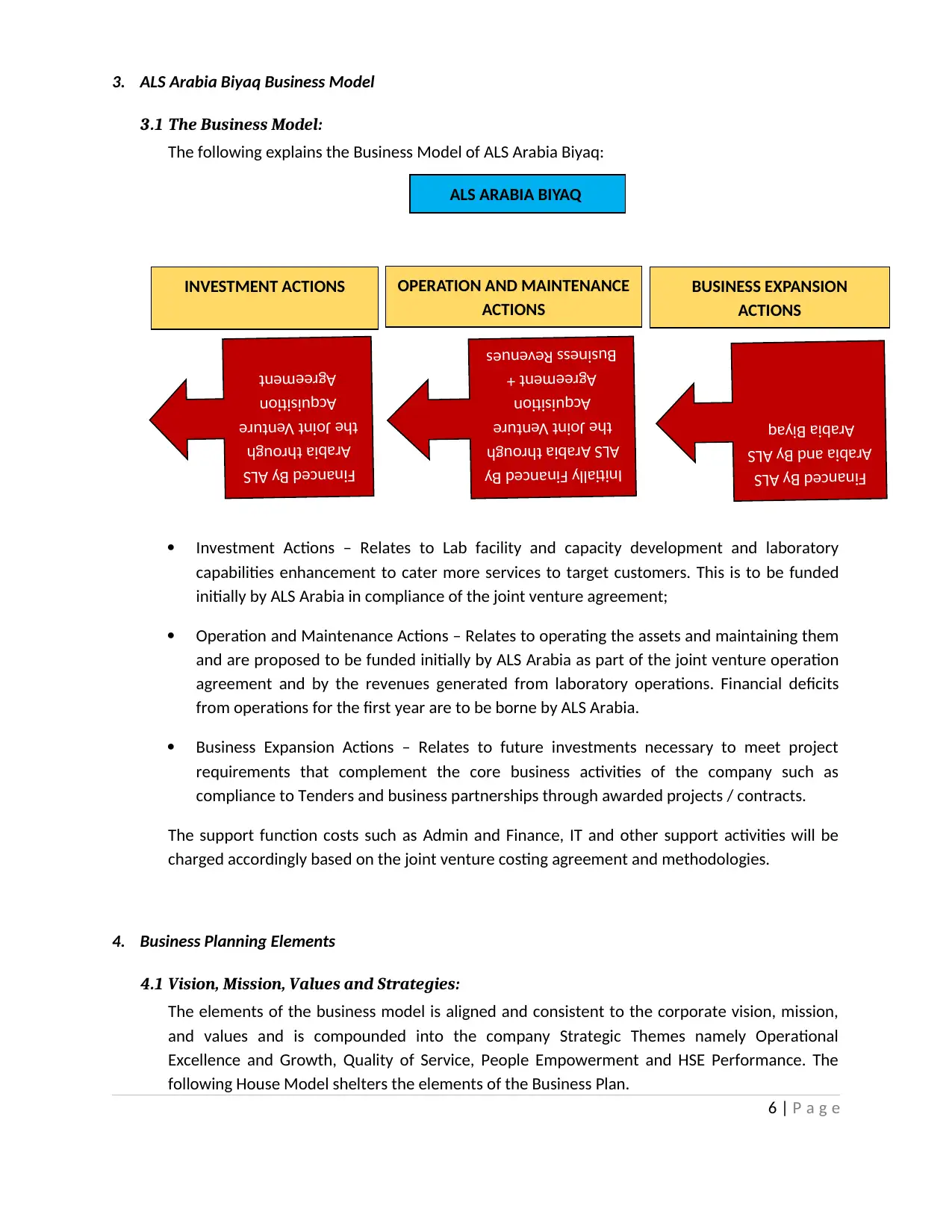
3. ALS Arabia Biyaq Business Model
3.1 The Business Model:
The following explains the Business Model of ALS Arabia Biyaq:
Investment Actions – Relates to Lab facility and capacity development and laboratory
capabilities enhancement to cater more services to target customers. This is to be funded
initially by ALS Arabia in compliance of the joint venture agreement;
Operation and Maintenance Actions – Relates to operating the assets and maintaining them
and are proposed to be funded initially by ALS Arabia as part of the joint venture operation
agreement and by the revenues generated from laboratory operations. Financial deficits
from operations for the first year are to be borne by ALS Arabia.
Business Expansion Actions – Relates to future investments necessary to meet project
requirements that complement the core business activities of the company such as
compliance to Tenders and business partnerships through awarded projects / contracts.
The support function costs such as Admin and Finance, IT and other support activities will be
charged accordingly based on the joint venture costing agreement and methodologies.
4. Business Planning Elements
4.1 Vision, Mission, Values and Strategies:
The elements of the business model is aligned and consistent to the corporate vision, mission,
and values and is compounded into the company Strategic Themes namely Operational
Excellence and Growth, Quality of Service, People Empowerment and HSE Performance. The
following House Model shelters the elements of the Business Plan.
6 | P a g e
Financed By ALS
Arabia through
the Joint Venture
Acquisition
Agreement
Initially Financed By
ALS Arabia through
the Joint Venture
Acquisition
Agreement +
Business Revenues
Financed By ALS
Arabia and By ALS
Arabia Biyaq
INVESTMENT ACTIONS BUSINESS EXPANSION
ACTIONS
ALS ARABIA BIYAQ
OPERATION AND MAINTENANCE
ACTIONS
3.1 The Business Model:
The following explains the Business Model of ALS Arabia Biyaq:
Investment Actions – Relates to Lab facility and capacity development and laboratory
capabilities enhancement to cater more services to target customers. This is to be funded
initially by ALS Arabia in compliance of the joint venture agreement;
Operation and Maintenance Actions – Relates to operating the assets and maintaining them
and are proposed to be funded initially by ALS Arabia as part of the joint venture operation
agreement and by the revenues generated from laboratory operations. Financial deficits
from operations for the first year are to be borne by ALS Arabia.
Business Expansion Actions – Relates to future investments necessary to meet project
requirements that complement the core business activities of the company such as
compliance to Tenders and business partnerships through awarded projects / contracts.
The support function costs such as Admin and Finance, IT and other support activities will be
charged accordingly based on the joint venture costing agreement and methodologies.
4. Business Planning Elements
4.1 Vision, Mission, Values and Strategies:
The elements of the business model is aligned and consistent to the corporate vision, mission,
and values and is compounded into the company Strategic Themes namely Operational
Excellence and Growth, Quality of Service, People Empowerment and HSE Performance. The
following House Model shelters the elements of the Business Plan.
6 | P a g e
Financed By ALS
Arabia through
the Joint Venture
Acquisition
Agreement
Initially Financed By
ALS Arabia through
the Joint Venture
Acquisition
Agreement +
Business Revenues
Financed By ALS
Arabia and By ALS
Arabia Biyaq
INVESTMENT ACTIONS BUSINESS EXPANSION
ACTIONS
ALS ARABIA BIYAQ
OPERATION AND MAINTENANCE
ACTIONS
⊘ This is a preview!⊘
Do you want full access?
Subscribe today to unlock all pages.

Trusted by 1+ million students worldwide
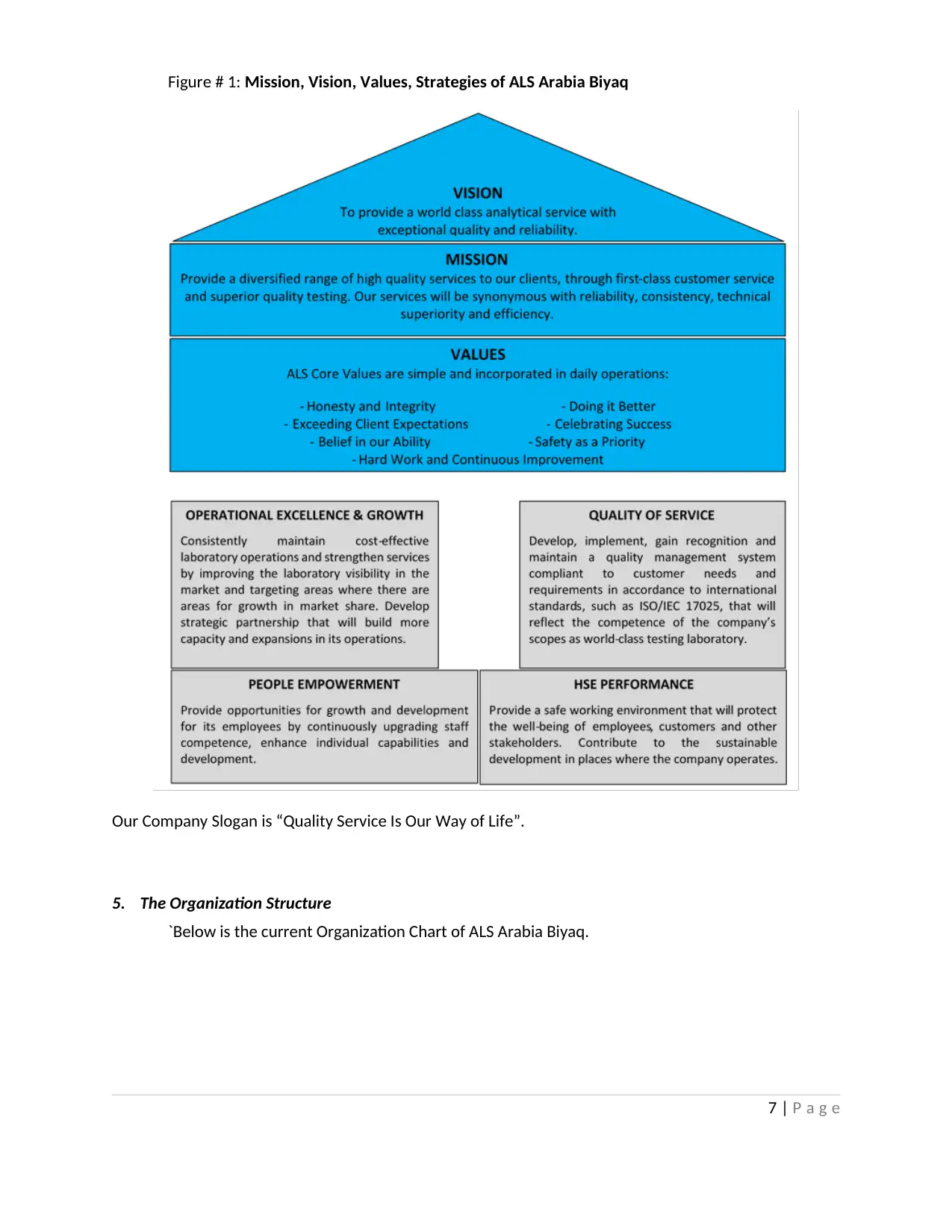
Figure # 1: Mission, Vision, Values, Strategies of ALS Arabia Biyaq
Our Company Slogan is “Quality Service Is Our Way of Life”.
5. The Organization Structure
`Below is the current Organization Chart of ALS Arabia Biyaq.
7 | P a g e
Our Company Slogan is “Quality Service Is Our Way of Life”.
5. The Organization Structure
`Below is the current Organization Chart of ALS Arabia Biyaq.
7 | P a g e
Paraphrase This Document
Need a fresh take? Get an instant paraphrase of this document with our AI Paraphraser
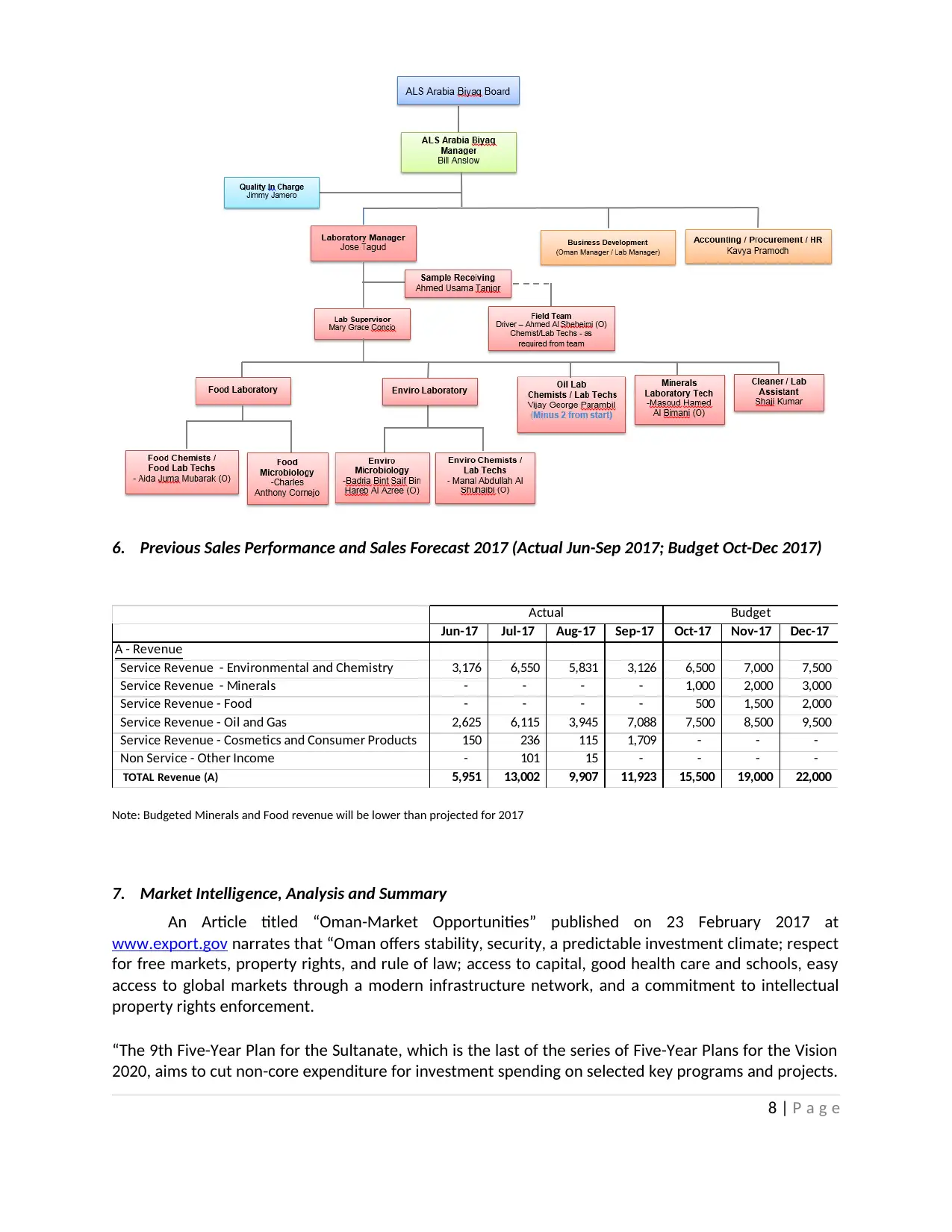
6. Previous Sales Performance and Sales Forecast 2017 (Actual Jun-Sep 2017; Budget Oct-Dec 2017)
Jun-17 Jul-17 Aug-17 Sep-17 Oct-17 Nov-17 Dec-17
A - Revenue
Service Revenue - Environmental and Chemistry 3,176 6,550 5,831 3,126 6,500 7,000 7,500
Service Revenue - Minerals - - - - 1,000 2,000 3,000
Service Revenue - Food - - - - 500 1,500 2,000
Service Revenue - Oil and Gas 2,625 6,115 3,945 7,088 7,500 8,500 9,500
Service Revenue - Cosmetics and Consumer Products 150 236 115 1,709 - - -
Non Service - Other Income - 101 15 - - - -
TOTAL Revenue (A) 5,951 13,002 9,907 11,923 15,500 19,000 22,000
Actual Budget
Note: Budgeted Minerals and Food revenue will be lower than projected for 2017
7. Market Intelligence, Analysis and Summary
An Article titled “Oman-Market Opportunities” published on 23 February 2017 at
www.export.gov narrates that “Oman offers stability, security, a predictable investment climate; respect
for free markets, property rights, and rule of law; access to capital, good health care and schools, easy
access to global markets through a modern infrastructure network, and a commitment to intellectual
property rights enforcement.
“The 9th Five-Year Plan for the Sultanate, which is the last of the series of Five-Year Plans for the Vision
2020, aims to cut non-core expenditure for investment spending on selected key programs and projects.
8 | P a g e
Jun-17 Jul-17 Aug-17 Sep-17 Oct-17 Nov-17 Dec-17
A - Revenue
Service Revenue - Environmental and Chemistry 3,176 6,550 5,831 3,126 6,500 7,000 7,500
Service Revenue - Minerals - - - - 1,000 2,000 3,000
Service Revenue - Food - - - - 500 1,500 2,000
Service Revenue - Oil and Gas 2,625 6,115 3,945 7,088 7,500 8,500 9,500
Service Revenue - Cosmetics and Consumer Products 150 236 115 1,709 - - -
Non Service - Other Income - 101 15 - - - -
TOTAL Revenue (A) 5,951 13,002 9,907 11,923 15,500 19,000 22,000
Actual Budget
Note: Budgeted Minerals and Food revenue will be lower than projected for 2017
7. Market Intelligence, Analysis and Summary
An Article titled “Oman-Market Opportunities” published on 23 February 2017 at
www.export.gov narrates that “Oman offers stability, security, a predictable investment climate; respect
for free markets, property rights, and rule of law; access to capital, good health care and schools, easy
access to global markets through a modern infrastructure network, and a commitment to intellectual
property rights enforcement.
“The 9th Five-Year Plan for the Sultanate, which is the last of the series of Five-Year Plans for the Vision
2020, aims to cut non-core expenditure for investment spending on selected key programs and projects.
8 | P a g e
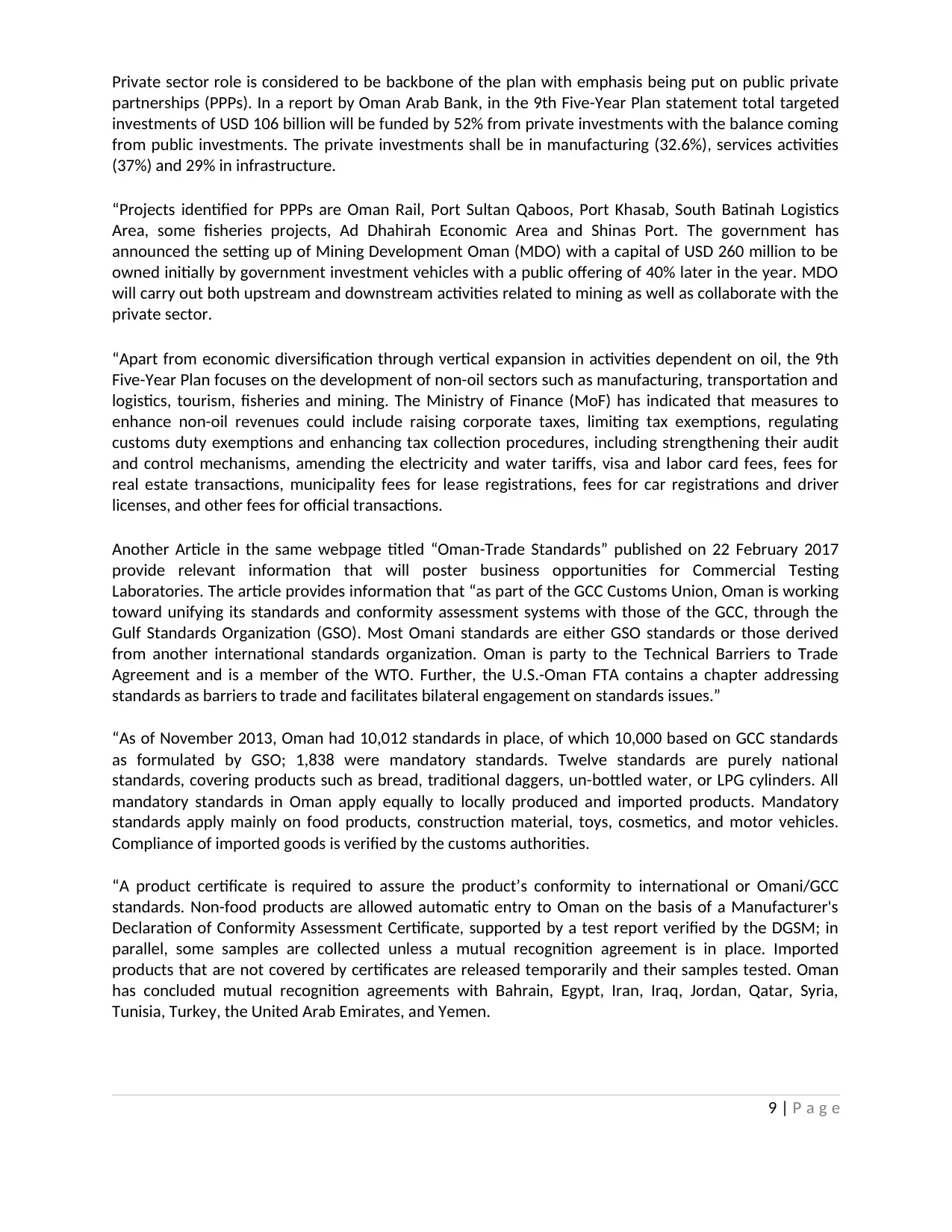
Private sector role is considered to be backbone of the plan with emphasis being put on public private
partnerships (PPPs). In a report by Oman Arab Bank, in the 9th Five-Year Plan statement total targeted
investments of USD 106 billion will be funded by 52% from private investments with the balance coming
from public investments. The private investments shall be in manufacturing (32.6%), services activities
(37%) and 29% in infrastructure.
“Projects identified for PPPs are Oman Rail, Port Sultan Qaboos, Port Khasab, South Batinah Logistics
Area, some fisheries projects, Ad Dhahirah Economic Area and Shinas Port. The government has
announced the setting up of Mining Development Oman (MDO) with a capital of USD 260 million to be
owned initially by government investment vehicles with a public offering of 40% later in the year. MDO
will carry out both upstream and downstream activities related to mining as well as collaborate with the
private sector.
“Apart from economic diversification through vertical expansion in activities dependent on oil, the 9th
Five-Year Plan focuses on the development of non-oil sectors such as manufacturing, transportation and
logistics, tourism, fisheries and mining. The Ministry of Finance (MoF) has indicated that measures to
enhance non-oil revenues could include raising corporate taxes, limiting tax exemptions, regulating
customs duty exemptions and enhancing tax collection procedures, including strengthening their audit
and control mechanisms, amending the electricity and water tariffs, visa and labor card fees, fees for
real estate transactions, municipality fees for lease registrations, fees for car registrations and driver
licenses, and other fees for official transactions.
Another Article in the same webpage titled “Oman-Trade Standards” published on 22 February 2017
provide relevant information that will poster business opportunities for Commercial Testing
Laboratories. The article provides information that “as part of the GCC Customs Union, Oman is working
toward unifying its standards and conformity assessment systems with those of the GCC, through the
Gulf Standards Organization (GSO). Most Omani standards are either GSO standards or those derived
from another international standards organization. Oman is party to the Technical Barriers to Trade
Agreement and is a member of the WTO. Further, the U.S.-Oman FTA contains a chapter addressing
standards as barriers to trade and facilitates bilateral engagement on standards issues.”
“As of November 2013, Oman had 10,012 standards in place, of which 10,000 based on GCC standards
as formulated by GSO; 1,838 were mandatory standards. Twelve standards are purely national
standards, covering products such as bread, traditional daggers, un-bottled water, or LPG cylinders. All
mandatory standards in Oman apply equally to locally produced and imported products. Mandatory
standards apply mainly on food products, construction material, toys, cosmetics, and motor vehicles.
Compliance of imported goods is verified by the customs authorities.
“A product certificate is required to assure the product’s conformity to international or Omani/GCC
standards. Non-food products are allowed automatic entry to Oman on the basis of a Manufacturer's
Declaration of Conformity Assessment Certificate, supported by a test report verified by the DGSM; in
parallel, some samples are collected unless a mutual recognition agreement is in place. Imported
products that are not covered by certificates are released temporarily and their samples tested. Oman
has concluded mutual recognition agreements with Bahrain, Egypt, Iran, Iraq, Jordan, Qatar, Syria,
Tunisia, Turkey, the United Arab Emirates, and Yemen.
9 | P a g e
partnerships (PPPs). In a report by Oman Arab Bank, in the 9th Five-Year Plan statement total targeted
investments of USD 106 billion will be funded by 52% from private investments with the balance coming
from public investments. The private investments shall be in manufacturing (32.6%), services activities
(37%) and 29% in infrastructure.
“Projects identified for PPPs are Oman Rail, Port Sultan Qaboos, Port Khasab, South Batinah Logistics
Area, some fisheries projects, Ad Dhahirah Economic Area and Shinas Port. The government has
announced the setting up of Mining Development Oman (MDO) with a capital of USD 260 million to be
owned initially by government investment vehicles with a public offering of 40% later in the year. MDO
will carry out both upstream and downstream activities related to mining as well as collaborate with the
private sector.
“Apart from economic diversification through vertical expansion in activities dependent on oil, the 9th
Five-Year Plan focuses on the development of non-oil sectors such as manufacturing, transportation and
logistics, tourism, fisheries and mining. The Ministry of Finance (MoF) has indicated that measures to
enhance non-oil revenues could include raising corporate taxes, limiting tax exemptions, regulating
customs duty exemptions and enhancing tax collection procedures, including strengthening their audit
and control mechanisms, amending the electricity and water tariffs, visa and labor card fees, fees for
real estate transactions, municipality fees for lease registrations, fees for car registrations and driver
licenses, and other fees for official transactions.
Another Article in the same webpage titled “Oman-Trade Standards” published on 22 February 2017
provide relevant information that will poster business opportunities for Commercial Testing
Laboratories. The article provides information that “as part of the GCC Customs Union, Oman is working
toward unifying its standards and conformity assessment systems with those of the GCC, through the
Gulf Standards Organization (GSO). Most Omani standards are either GSO standards or those derived
from another international standards organization. Oman is party to the Technical Barriers to Trade
Agreement and is a member of the WTO. Further, the U.S.-Oman FTA contains a chapter addressing
standards as barriers to trade and facilitates bilateral engagement on standards issues.”
“As of November 2013, Oman had 10,012 standards in place, of which 10,000 based on GCC standards
as formulated by GSO; 1,838 were mandatory standards. Twelve standards are purely national
standards, covering products such as bread, traditional daggers, un-bottled water, or LPG cylinders. All
mandatory standards in Oman apply equally to locally produced and imported products. Mandatory
standards apply mainly on food products, construction material, toys, cosmetics, and motor vehicles.
Compliance of imported goods is verified by the customs authorities.
“A product certificate is required to assure the product’s conformity to international or Omani/GCC
standards. Non-food products are allowed automatic entry to Oman on the basis of a Manufacturer's
Declaration of Conformity Assessment Certificate, supported by a test report verified by the DGSM; in
parallel, some samples are collected unless a mutual recognition agreement is in place. Imported
products that are not covered by certificates are released temporarily and their samples tested. Oman
has concluded mutual recognition agreements with Bahrain, Egypt, Iran, Iraq, Jordan, Qatar, Syria,
Tunisia, Turkey, the United Arab Emirates, and Yemen.
9 | P a g e
⊘ This is a preview!⊘
Do you want full access?
Subscribe today to unlock all pages.

Trusted by 1+ million students worldwide
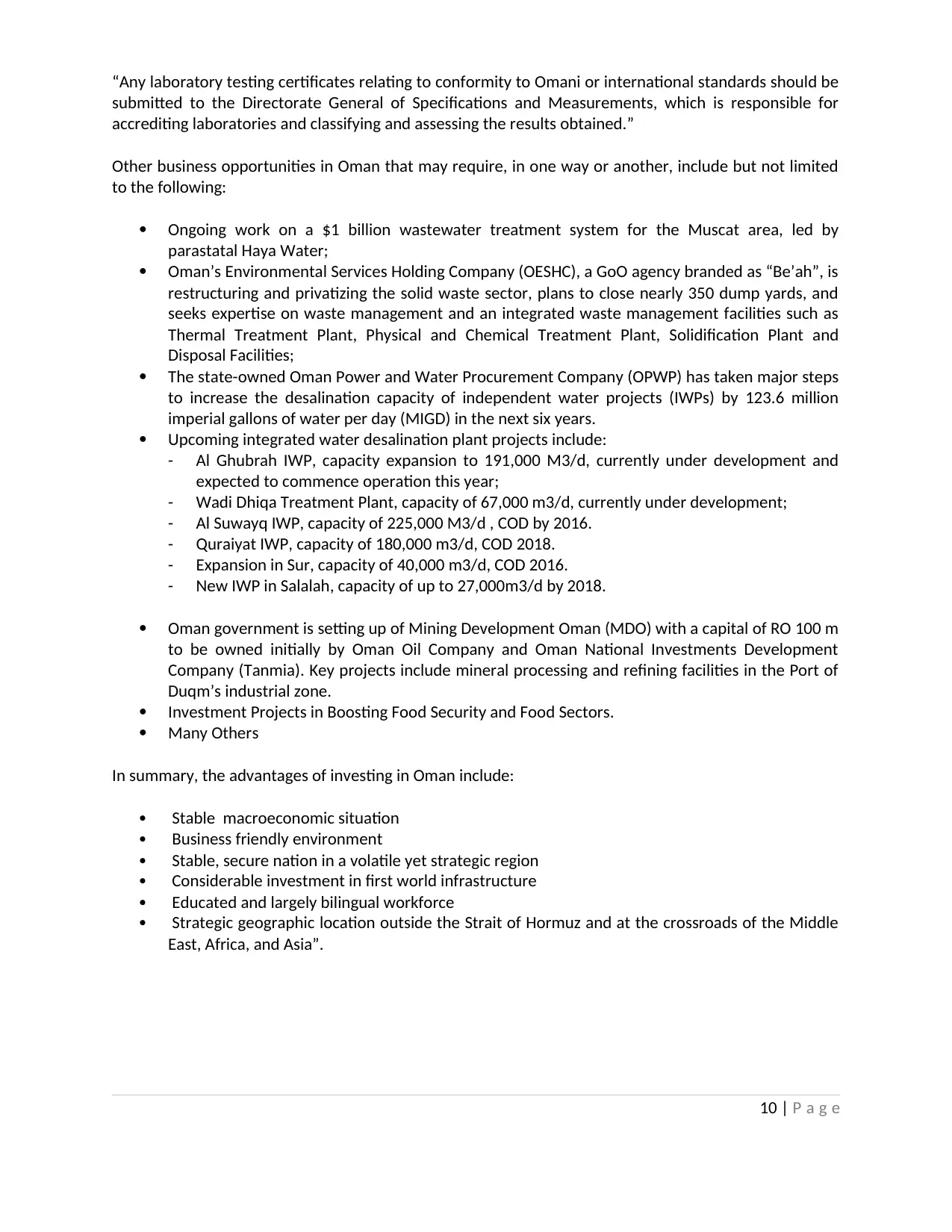
“Any laboratory testing certificates relating to conformity to Omani or international standards should be
submitted to the Directorate General of Specifications and Measurements, which is responsible for
accrediting laboratories and classifying and assessing the results obtained.”
Other business opportunities in Oman that may require, in one way or another, include but not limited
to the following:
Ongoing work on a $1 billion wastewater treatment system for the Muscat area, led by
parastatal Haya Water;
Oman’s Environmental Services Holding Company (OESHC), a GoO agency branded as “Be’ah”, is
restructuring and privatizing the solid waste sector, plans to close nearly 350 dump yards, and
seeks expertise on waste management and an integrated waste management facilities such as
Thermal Treatment Plant, Physical and Chemical Treatment Plant, Solidification Plant and
Disposal Facilities;
The state-owned Oman Power and Water Procurement Company (OPWP) has taken major steps
to increase the desalination capacity of independent water projects (IWPs) by 123.6 million
imperial gallons of water per day (MIGD) in the next six years.
Upcoming integrated water desalination plant projects include:
- Al Ghubrah IWP, capacity expansion to 191,000 M3/d, currently under development and
expected to commence operation this year;
- Wadi Dhiqa Treatment Plant, capacity of 67,000 m3/d, currently under development;
- Al Suwayq IWP, capacity of 225,000 M3/d , COD by 2016.
- Quraiyat IWP, capacity of 180,000 m3/d, COD 2018.
- Expansion in Sur, capacity of 40,000 m3/d, COD 2016.
- New IWP in Salalah, capacity of up to 27,000m3/d by 2018.
Oman government is setting up of Mining Development Oman (MDO) with a capital of RO 100 m
to be owned initially by Oman Oil Company and Oman National Investments Development
Company (Tanmia). Key projects include mineral processing and refining facilities in the Port of
Duqm’s industrial zone.
Investment Projects in Boosting Food Security and Food Sectors.
Many Others
In summary, the advantages of investing in Oman include:
Stable macroeconomic situation
Business friendly environment
Stable, secure nation in a volatile yet strategic region
Considerable investment in first world infrastructure
Educated and largely bilingual workforce
Strategic geographic location outside the Strait of Hormuz and at the crossroads of the Middle
East, Africa, and Asia”.
10 | P a g e
submitted to the Directorate General of Specifications and Measurements, which is responsible for
accrediting laboratories and classifying and assessing the results obtained.”
Other business opportunities in Oman that may require, in one way or another, include but not limited
to the following:
Ongoing work on a $1 billion wastewater treatment system for the Muscat area, led by
parastatal Haya Water;
Oman’s Environmental Services Holding Company (OESHC), a GoO agency branded as “Be’ah”, is
restructuring and privatizing the solid waste sector, plans to close nearly 350 dump yards, and
seeks expertise on waste management and an integrated waste management facilities such as
Thermal Treatment Plant, Physical and Chemical Treatment Plant, Solidification Plant and
Disposal Facilities;
The state-owned Oman Power and Water Procurement Company (OPWP) has taken major steps
to increase the desalination capacity of independent water projects (IWPs) by 123.6 million
imperial gallons of water per day (MIGD) in the next six years.
Upcoming integrated water desalination plant projects include:
- Al Ghubrah IWP, capacity expansion to 191,000 M3/d, currently under development and
expected to commence operation this year;
- Wadi Dhiqa Treatment Plant, capacity of 67,000 m3/d, currently under development;
- Al Suwayq IWP, capacity of 225,000 M3/d , COD by 2016.
- Quraiyat IWP, capacity of 180,000 m3/d, COD 2018.
- Expansion in Sur, capacity of 40,000 m3/d, COD 2016.
- New IWP in Salalah, capacity of up to 27,000m3/d by 2018.
Oman government is setting up of Mining Development Oman (MDO) with a capital of RO 100 m
to be owned initially by Oman Oil Company and Oman National Investments Development
Company (Tanmia). Key projects include mineral processing and refining facilities in the Port of
Duqm’s industrial zone.
Investment Projects in Boosting Food Security and Food Sectors.
Many Others
In summary, the advantages of investing in Oman include:
Stable macroeconomic situation
Business friendly environment
Stable, secure nation in a volatile yet strategic region
Considerable investment in first world infrastructure
Educated and largely bilingual workforce
Strategic geographic location outside the Strait of Hormuz and at the crossroads of the Middle
East, Africa, and Asia”.
10 | P a g e
Paraphrase This Document
Need a fresh take? Get an instant paraphrase of this document with our AI Paraphraser
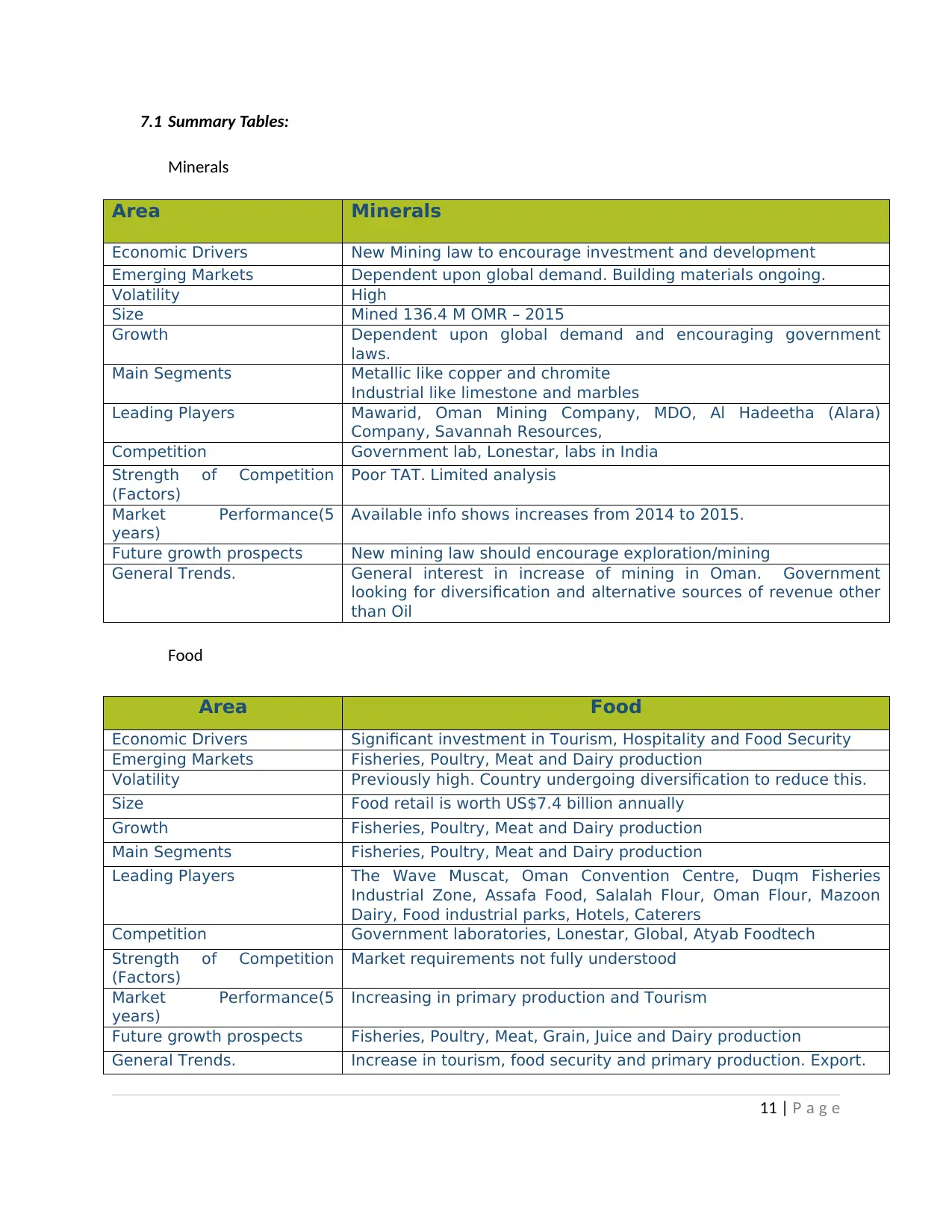
7.1 Summary Tables:
Minerals
Area Minerals
Economic Drivers New Mining law to encourage investment and development
Emerging Markets Dependent upon global demand. Building materials ongoing.
Volatility High
Size Mined 136.4 M OMR – 2015
Growth Dependent upon global demand and encouraging government
laws.
Main Segments Metallic like copper and chromite
Industrial like limestone and marbles
Leading Players Mawarid, Oman Mining Company, MDO, Al Hadeetha (Alara)
Company, Savannah Resources,
Competition Government lab, Lonestar, labs in India
Strength of Competition
(Factors)
Poor TAT. Limited analysis
Market Performance(5
years)
Available info shows increases from 2014 to 2015.
Future growth prospects New mining law should encourage exploration/mining
General Trends. General interest in increase of mining in Oman. Government
looking for diversification and alternative sources of revenue other
than Oil
Food
11 | P a g e
Area Food
Economic Drivers Significant investment in Tourism, Hospitality and Food Security
Emerging Markets Fisheries, Poultry, Meat and Dairy production
Volatility Previously high. Country undergoing diversification to reduce this.
Size Food retail is worth US$7.4 billion annually
Growth Fisheries, Poultry, Meat and Dairy production
Main Segments Fisheries, Poultry, Meat and Dairy production
Leading Players The Wave Muscat, Oman Convention Centre, Duqm Fisheries
Industrial Zone, Assafa Food, Salalah Flour, Oman Flour, Mazoon
Dairy, Food industrial parks, Hotels, Caterers
Competition Government laboratories, Lonestar, Global, Atyab Foodtech
Strength of Competition
(Factors)
Market requirements not fully understood
Market Performance(5
years)
Increasing in primary production and Tourism
Future growth prospects Fisheries, Poultry, Meat, Grain, Juice and Dairy production
General Trends. Increase in tourism, food security and primary production. Export.
Minerals
Area Minerals
Economic Drivers New Mining law to encourage investment and development
Emerging Markets Dependent upon global demand. Building materials ongoing.
Volatility High
Size Mined 136.4 M OMR – 2015
Growth Dependent upon global demand and encouraging government
laws.
Main Segments Metallic like copper and chromite
Industrial like limestone and marbles
Leading Players Mawarid, Oman Mining Company, MDO, Al Hadeetha (Alara)
Company, Savannah Resources,
Competition Government lab, Lonestar, labs in India
Strength of Competition
(Factors)
Poor TAT. Limited analysis
Market Performance(5
years)
Available info shows increases from 2014 to 2015.
Future growth prospects New mining law should encourage exploration/mining
General Trends. General interest in increase of mining in Oman. Government
looking for diversification and alternative sources of revenue other
than Oil
Food
11 | P a g e
Area Food
Economic Drivers Significant investment in Tourism, Hospitality and Food Security
Emerging Markets Fisheries, Poultry, Meat and Dairy production
Volatility Previously high. Country undergoing diversification to reduce this.
Size Food retail is worth US$7.4 billion annually
Growth Fisheries, Poultry, Meat and Dairy production
Main Segments Fisheries, Poultry, Meat and Dairy production
Leading Players The Wave Muscat, Oman Convention Centre, Duqm Fisheries
Industrial Zone, Assafa Food, Salalah Flour, Oman Flour, Mazoon
Dairy, Food industrial parks, Hotels, Caterers
Competition Government laboratories, Lonestar, Global, Atyab Foodtech
Strength of Competition
(Factors)
Market requirements not fully understood
Market Performance(5
years)
Increasing in primary production and Tourism
Future growth prospects Fisheries, Poultry, Meat, Grain, Juice and Dairy production
General Trends. Increase in tourism, food security and primary production. Export.
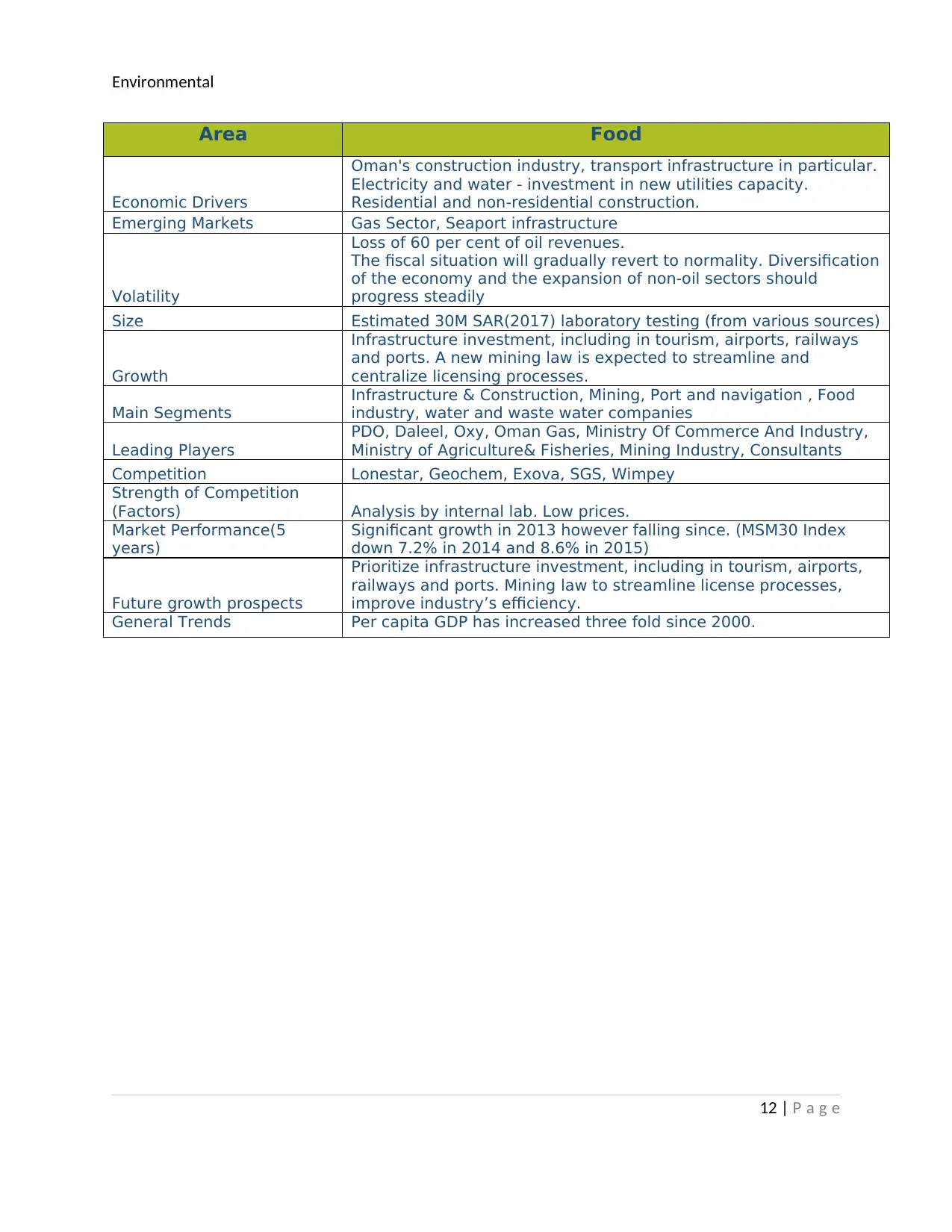
Environmental
12 | P a g e
Area Food
Economic Drivers
Oman's construction industry, transport infrastructure in particular.
Electricity and water - investment in new utilities capacity.
Residential and non-residential construction.
Emerging Markets Gas Sector, Seaport infrastructure
Volatility
Loss of 60 per cent of oil revenues.
The fiscal situation will gradually revert to normality. Diversification
of the economy and the expansion of non-oil sectors should
progress steadily
Size Estimated 30M SAR(2017) laboratory testing (from various sources)
Growth
Infrastructure investment, including in tourism, airports, railways
and ports. A new mining law is expected to streamline and
centralize licensing processes.
Main Segments
Infrastructure & Construction, Mining, Port and navigation , Food
industry, water and waste water companies
Leading Players
PDO, Daleel, Oxy, Oman Gas, Ministry Of Commerce And Industry,
Ministry of Agriculture& Fisheries, Mining Industry, Consultants
Competition Lonestar, Geochem, Exova, SGS, Wimpey
Strength of Competition
(Factors) Analysis by internal lab. Low prices.
Market Performance(5
years)
Significant growth in 2013 however falling since. (MSM30 Index
down 7.2% in 2014 and 8.6% in 2015)
Future growth prospects
Prioritize infrastructure investment, including in tourism, airports,
railways and ports. Mining law to streamline license processes,
improve industry’s efficiency.
General Trends Per capita GDP has increased three fold since 2000.
12 | P a g e
Area Food
Economic Drivers
Oman's construction industry, transport infrastructure in particular.
Electricity and water - investment in new utilities capacity.
Residential and non-residential construction.
Emerging Markets Gas Sector, Seaport infrastructure
Volatility
Loss of 60 per cent of oil revenues.
The fiscal situation will gradually revert to normality. Diversification
of the economy and the expansion of non-oil sectors should
progress steadily
Size Estimated 30M SAR(2017) laboratory testing (from various sources)
Growth
Infrastructure investment, including in tourism, airports, railways
and ports. A new mining law is expected to streamline and
centralize licensing processes.
Main Segments
Infrastructure & Construction, Mining, Port and navigation , Food
industry, water and waste water companies
Leading Players
PDO, Daleel, Oxy, Oman Gas, Ministry Of Commerce And Industry,
Ministry of Agriculture& Fisheries, Mining Industry, Consultants
Competition Lonestar, Geochem, Exova, SGS, Wimpey
Strength of Competition
(Factors) Analysis by internal lab. Low prices.
Market Performance(5
years)
Significant growth in 2013 however falling since. (MSM30 Index
down 7.2% in 2014 and 8.6% in 2015)
Future growth prospects
Prioritize infrastructure investment, including in tourism, airports,
railways and ports. Mining law to streamline license processes,
improve industry’s efficiency.
General Trends Per capita GDP has increased three fold since 2000.
⊘ This is a preview!⊘
Do you want full access?
Subscribe today to unlock all pages.

Trusted by 1+ million students worldwide
1 out of 27
Related Documents
Your All-in-One AI-Powered Toolkit for Academic Success.
+13062052269
info@desklib.com
Available 24*7 on WhatsApp / Email
![[object Object]](/_next/static/media/star-bottom.7253800d.svg)
Unlock your academic potential
Copyright © 2020–2025 A2Z Services. All Rights Reserved. Developed and managed by ZUCOL.




